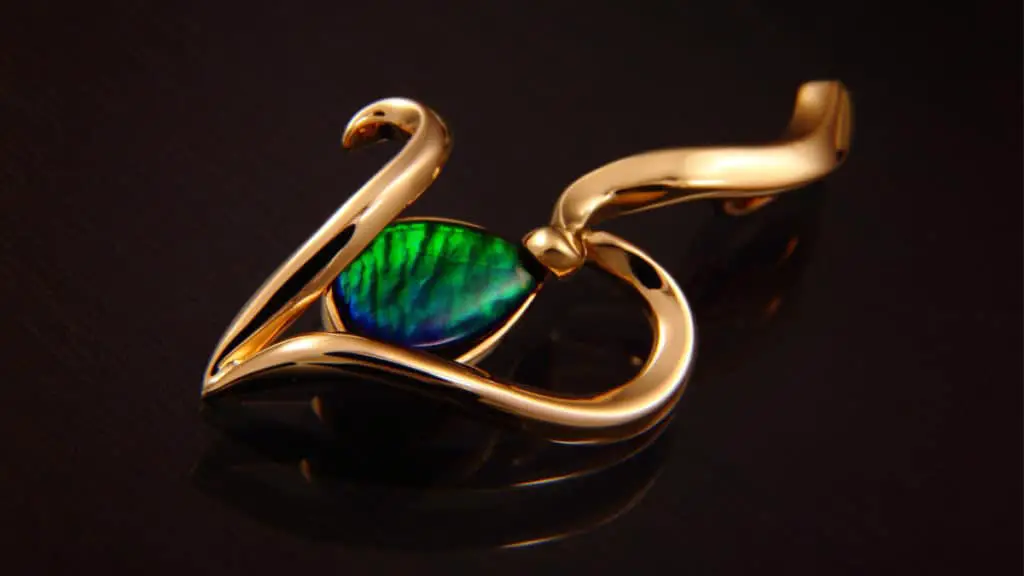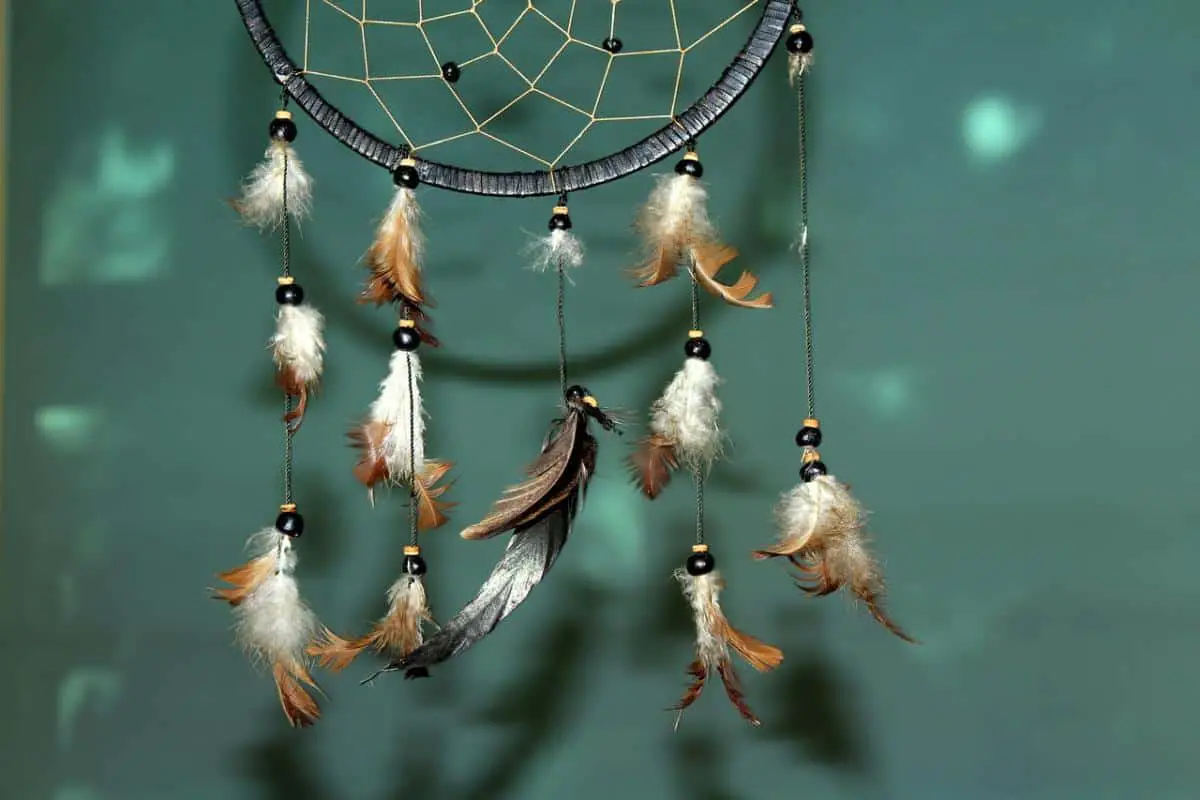After a trip, you often take them home for yourself or friends and family: souvenirs of your vacation. In many cases, they have little value. Fortunately, Banff National Park also has some unique and exciting mementos. Let’s have a look at what you can buy.
Which Souvenirs are Exclusively Available in Banff?
Souvenirs that you can (almost) only get in Banff National Park makes them interesting and/or worth buying. They represent something authentic of the region. Below is an overview of the top local products you can easily put in your luggage. The choice is still big enough so that there is almost always something interesting enough to take home.
Ammolite
Ammolite is perhaps the most unusual souvenir you can find in Banff National Park. Because it is used to make jewelry, ammolite makes a beautiful and valuable souvenir. But, I hear you ask, what exactly is ammolite?
Ammolite is an organic gemstone found mainly on the east side of the Rocky Mountains. It is very similar to the well-known opal and is also known as calcentine, aaopak and corite. Ammolite has a distinctive red and green color. It’s made from ammonite fossilized shells which in turn are primarily composed of aragonite.

The stone is found exclusively in North America and particularly in Alberta. An important site is the Bearpaw formation. It extends from Alberta to Saskatchewan in Canada and Montana in the United States. Gem-grade ammolite has also been found in Utah. Although it is found there in small quantities.
Ammolite has been used to make jewelry since 1967. Think necklaces, earrings, rings and brooches. They are available in many souvenir stores in the park. Feng Shui practitioners believe that the stone contains powers that improve well-being and detoxify the body by enhancing the flow of energy or “chi”.
Native Art
Those who enjoy art are sure to find something to their liking in Banff National Park. The park was home to Canada’s first peoples, such as the Blackfoot and Nakoda Indians, for more than 10,000 years. They used the Bow River to travel, hunt, and fish long before European settlers arrived.
In those cultures, there was plenty of room for art. They produced jewelry, woodcarving, quillwork, beading, bronze work, hides and dolls, etc. The “first nations” descendants still live in Alberta and Banff National Park. The art they produce today can be found in the many souvenir stores in the park.
With this “aboriginal art”, you get an authentic piece of Banff in your home representing the area’s culture and history of human activity. And it is beautiful too. So it’s worth looking into if you’re looking for a souvenir from the area.
Canada House Gallery
To get a good idea of what the indigenous art in Banff National Park is all about, I highly recommend visiting the Canada House Gallery. Located at 201 Bear Street in Banff, this gallery offers a wide variety of Indigenous artwork. You’ll find paintings by leading first nations artists, as well as sculptures and Inuit artwork.
Dreamcatcher
The Native American tribes in Banff National Park have traditionally made dreamcatchers. Dreamcatchers are handmade rings of (usually) willow into which a web or net is woven. Hanging from that ring are – for Native Americans – sacred feathers or beads. Originally from the Ojibwe Nation, Dreamcatchers are generally considered a sign of Native American identity.
Dreamcatchers serve to protect babies and children and catch ‘any evil that hangs in the air, as a spider’s web catches and holds everything that comes in contact with it’. [Densmore, Frances (1929, 1979) Chippewa Customs. Minn. Hist. Soc. Press; pg. 113.].
Therefore, they are traditionally hung on the crib or bed. More recently, dreamcatchers have been used to symbolize hope and healing. Dreamcatchers, therefore, are not exclusively connected to dreams.
Each part of the dreamcatcher has a meaning connected to the physical world. For example, the round shape represents the spherical nature of the earth. The web is said to absorb bad dreams at night to discharge them during the day. The hanging feathers act as ladders allowing positive dreams to descend on the sleeping baby or child.
Incidentally, the term dream catcher does not come from native people. It was coined by the media when the object began to gain popularity in the 1970s and 1980s.
Local Liquor
Liquor, of course, is always a good and welcome souvenir. And yes, liquor is also produced in Banff National Park. Think of products like whiskey, vodka, gin and rye whiskey. Glacier water from the Rockies is used, among other ingredients. Whether you really taste this, or whether it’s mainly a clever marketing ploy, I haven’t been able to find out. In any case, it sounds good.
In Banff, you’ll find the Park Distillery at 219 Banff Avenue. Here they make products like Park Classic vodka, Park Alpine dry gin, Park Vanilla vodka, Park Bird’s Eye Chili Vodka, Park Espresso vodka, Park Maple rye and Park Glacier rye. The company also sells gift packs of various products.
Alberta Distillers Limited also makes some (more or less) local whiskeys and vodkas, such as Alberta Premium, Banff Ice vodka, Banff Ice Summit vodka, Alberta Springs. You can find these drinks at liquor stores in Banff and Lake Louise.
Typically Canadian
If you don’t find the above products interesting (enough), and you necessarily want to take home a souvenir, it’s helpful to know what things Canada is known for. It may help you search for a souvenir that will appeal to you Below you’ll find a random list of products. There are (many) more, but these are some of the best-known ones.
Maple Syrup
The product that perhaps stands out the most is maple syrup. This delightful treacle is extracted from maple trees in Quebec in particular. This province is responsible for a whopping seventy percent of the world’s maple syrup production. Why do you think Canada has the “maple leaf” in its flag?
Maple syrup is primarily used on pancake waffles and French toast. It is also incorporated into numerous sweet products, such as lollipops, cookies and candies.
Icewine
Typically Canadian: ice wine. You might expect mulled wine in a country that gets very cold in the winter, but it is wine made from frozen grapes.
Ice wine is a sweet wine in which frozen grapes are picked and pressed at an air temperature of -8° Celsius (-17.6° Fahrenheit). The juice thus produced has very high sugar content. This procedure creates a sweet and luscious flavor.
Vintners are not allowed to simply use the term “ice wine”. The grapes must have been frozen naturally and the sugar content must be 35° Brix (the sugar content of an aqueous solution) or higher.
Butter Tarts
Sweet tooth beware! Butter tarts are a typical Canadian treat that you absolutely must have tried. This pastry consists of a filling of butter, egg, syrup and sugar, baked in a dough shell and topped with a crunchy topping.
Of course, butter tarts from the bakery are the tastiest. Still, those who like to take them back home pre-packaged can find them in many Canadian supermarkets and convenience stores.
Smoked Salmon
For many people a treat, a slice of fresh salmon. Canada excels at it. Much of the salmon are caught on the west coast in British Columbia. Typically Canadian is the smoked variety. If you want to eat it the Canadian way, serve the salmon with salt, cream cheese and lemon.
Smoked salmon is not cheap, but if you love fish this is an absolute must-buy. And because vacuum-packed smoked salmon has a shelf life of two to three weeks, you can take it with you on the plane or in the car without a problem.
Molson Beer
If you like beer, you can’t ignore the brand Molson Canadian in Canada. With five percent alcohol, this is a so-called lager (or “bottom-fermented” beer). Although I don’t like beer myself, it should make for an excellent pint. The Montreal-based brand won the international Monde Selection award no less than six times and it won the Canadian Brewing Award in 2006.
Crown Royal Whiskey
Those who prefer something stronger and want to drink something typically Canadian soon end up with Crown Royal whiskey. This whiskey was introduced in 1939 to mark the visit of King George VI and Queen Elizabeth in 1939, the first time a reigning British monarch visited North America.
Samuel Bronfman was responsible for the production of this whiskey. Bronfman was a Canadian businessman and philanthropist and had founded Distillers Corporation Limited with his brothers in 1924.
He tested more than 600 blends (mixtures) before pouring the finished product into a “cut glass decanter and a royal purple bag with gold stitching”, according to the brand’s website. The whiskey he presented to the king and queen was an “exquisitely smooth blend of about fifty whiskeys”.
Bears
Canada is often associated with bears. They live throughout almost the entire country and certainly in the Rocky Mountains of Banff National Park. That’s why you’ll find countless bear objects and souvenirs, such as stuffed bears (of course) and figurines, in all the park’s souvenir stores.
Where Can You Buy These Souvenirs?
In Banff National Park, you will find many souvenir stores. On Banff Avenue in Banff alone, you will find more than twenty (!). Furthermore, the Fairmont Banff Springs hotel has several. And in Lake Louise, you can find souvenirs in the Samson Mall and several stores in Château Lake Louise. Some hotels along the Icefields Parkway (Highway 93) and the Trans-Canada Highway (Highway 1) also sell souvenirs.
Restrictions on Bringing Souvenirs
Before you fly home, it’s good to know that there are restrictions on the amount and value of souvenirs you can bring.
These restrictions vary from country to country. Therefore, find out about them before your flight. Also, consider the countries you will be visiting during a stopover on your way to your final destination. You must also comply with the applicable laws of the country/countries in question.
Do You Have to Pay Import Duties on Souvenirs?
Again, the rules vary from country to country. Usually, you can bring in (import) goods from abroad duty-free for a low amount. Above that, a certain percentage of import duties applies to the value.
In practice, the contents of your luggage will not be checked on arrival in most cases. The chance is, therefore, small that you will actually have to pay something.
You can be fined for not declaring the products if you get checked. This can be the case when a customs officer finds a relatively large quantity of a particular product or a product with a relatively high value. So watch out for that.


